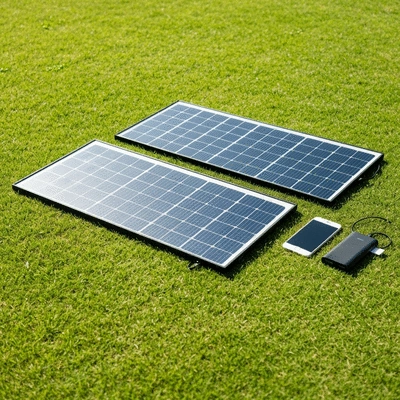The Best Portable Solar Panels for On-the-Go Power
In an increasingly mobile world, having a reliable power source is no longer a luxury but a necessity. Portable solar panels offer an eco-friendly and convenient way to keep your devices charged, whether you're camping, hiking, or experiencing a power outage. This guide will help you navigate the best options available in 2024, focusing on efficiency, durability, and portability.
Portable solar panels harness sunlight to generate electricity, which can then be used to charge smartphones, laptops, portable power stations, and even small appliances. They are ideal for off-grid adventures, emergency preparedness, and reducing your carbon footprint. When choosing a portable solar panel, consider factors like wattage, panel type (monocrystalline or polycrystalline), weight, folded size, and included accessories.

Top Picks for Portable Solar Panels
1. Jackery SolarSaga 100W
The Jackery SolarSaga 100W is a highly popular choice for its excellent balance of power, portability, and durability. It's designed to pair seamlessly with Jackery Explorer power stations, creating a robust solar generator system. Made with monocrystalline silicon cells, it boasts high conversion efficiency of up to 23%. Its foldable design with a magnetic handle makes it easy to transport and set up.
- Pros: High efficiency, durable ETFE material, easy to set up, kickstands included, compatible with Jackery power stations.
- Cons: A bit pricey, not waterproof (water-resistant only).
Ideal for camping, RVs, and emergency backup.
2. Goal Zero Nomad 200W
For those needing more power, the Goal Zero Nomad 200W delivers. It's built tough for outdoor adventures, featuring a durable design and integrated charging cables. While heavier than some 100W panels, its ability to quickly charge larger power stations makes it a favorite among serious campers and off-gridders. It also has a built-in chainable feature, allowing you to link multiple panels for even more power.
- Pros: High wattage, rugged design, chainable, integrated charging cables, good for larger power banks.
- Cons: Heavier and bulkier when folded, expensive.
Best for extended trips and higher power demands.
3. Anker 531 Solar Panel (200W)
Anker, known for its reliable charging accessories, offers the 531 Solar Panel with 200W output. This panel features a high conversion efficiency of up to 23% and is designed to be compatible with Anker's PowerHouse series. It's built with a durable, scratch-resistant surface and is IP67 waterproof, making it suitable for various outdoor conditions. The adjustable kickstand allows for optimal sun exposure.
- Pros: High efficiency, IP67 waterproof, durable build, compatible with Anker power stations, adjustable kickstand.
- Cons: Can be heavy, higher price point.
Great for all-weather outdoor use and fast charging.
4. Renogy 100W Foldable Solar Suitcase
Renogy is a well-respected name in solar, and their 100W Foldable Solar Suitcase is a complete plug-and-play solution. It comes with a built-in charge controller, making it easy to connect directly to a 12V battery. The suitcase design protects the panels during transport and makes setup a breeze. It's a great option for RVs, vans, and marine applications.
- Pros: All-in-one solution with charge controller, sturdy suitcase design, easy to set up, good for 12V batteries.
- Cons: Heavier than fabric panels, bulkier.
Excellent for RVs, vans, and direct battery charging.
Factors to Consider When Buying
- Wattage
- Determines how much power the panel can generate. Higher wattage means faster charging and the ability to power more devices simultaneously. Consider your power needs; a 100W panel is usually sufficient for small devices and power banks, while 200W+ is better for laptops and larger power stations.
- Efficiency
- Monocrystalline panels are generally more efficient (17-23%) than polycrystalline panels (13-17%), meaning they convert more sunlight into electricity in a smaller footprint. This is crucial for portable panels where space is often limited.
- Portability
- Look at the weight and folded dimensions. Lighter, more compact panels are better for backpacking, while heavier, more robust panels might be acceptable for car camping or RVs. Features like integrated handles and kickstands enhance portability and ease of use.
- Durability & Weather Resistance
- Outdoor gear needs to withstand the elements. Look for panels made with durable materials like ETFE and those with high IP ratings (e.g., IP65 or IP67) for water and dust resistance. This ensures your investment lasts through various weather conditions.
- Compatibility
- Ensure the panel is compatible with your existing power stations or devices. Many brands offer proprietary connectors, but most also include standard USB-A, USB-C, and DC outputs. Check the voltage and amperage specifications.
Choosing the right portable solar panel depends on your specific needs and activities. Whether you prioritize lightweight design for backpacking or high wattage for extended off-grid living, there's a panel out there for you. Invest in a quality portable solar panel to unlock reliable, renewable power wherever your adventures take you.
For more detailed reviews and comparisons, check out our in-depth guides on specific brands and models. Stay powered, stay connected!











